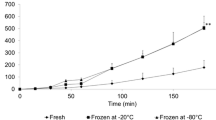Abstract
The potential of a mucoadhesive polymer as an ophthalmic vehicle is evaluated within the rabbit. Precorneal clearance of a mucoadhesive polymer solution (Carbopol 934P) is compared to that of an equiviscous nonmucoadhesive poly(vinyl alcohol) solution (PVA) and buffer (PBS). The precorneal retention of the Carbopol 934P, as studied by lacrimal dacryoscintigraphy, is shown to be significantly greater (P < 0.05) than that of PVA, which, in turn, is significantly greater than that of PBS. The effect of the polymer solution on the bioavailability of pilocarpine is subsequently assessed by measuring the relative miotic response intensities produced by a 1% solution of the drug. Carbopol 934P solution produces a significant increase (P < 0.05) in bioavailability as compared to PVA and PBS. The bioavailability from PVA is significantly greater (P < 0.05) than that from PBS. Studies evaluating vehicle-drug association indicated no binding of the drug to the polymer.
Similar content being viewed by others
REFERENCES
J. W. Shell. Pharmacokinetics of topically applied ophthalmic drugs. Surv. Ophthalmol. 26:207–218 (1982).
S. S. Chrai and J. R. Robinson. Ocular evaluation of methylcellulose vehicle in albino rabbits. J. Pharm. Sci. 63:1218–1223 (1974).
T. F. Patton and J. R. Robinson. Ocular evaluation of polyvinyl alcohol vehicle in rabbits. J. Pharm. Sci. 64:1312–1316 (1975).
D. A. Benedetto, D. O. Shah, and H. E. Kaufman. Instilled fluid dynamics and surface chemistry of polymers in the preocular tear film. Invest. Ophthalmol. 14:887–902 (1975).
M. A. Lemp and E. S. Szymanski. Polymer adsorption at the ocular surface. Arch. Ophthalmol. 93:134–136 (1975).
M. F. Saettone, B. Giannaccini, S. Ravecca, F. La Marca, and G. Tota. Polymer effects on ocular bioavailability—The influence of different liquid vehicles on the mydriatic response of tropicamide in humans and in rabbits. Int. J. Pharm. 20:187–202 (1984).
H. W. Hui and J. R. Robinson. Ocular delivery of progesterone using a bioadhesive polymer. Int. J. Pharm. 26:203–213 (1985).
R. Gurny, H. Ibrahim, A. Aebi, P. Buri, C. G. Wilson, N. Washington, P. Edman, and O. Camber. Design and evaluation of controlled release systems for the eye. J. Control. Rel. 6:367–373 (1987).
M. F. Saettone, P. Chetoni, M. T. Torracca, S. Burgalassi, and B. Giannaccini. Evaluation of muco-adhesive properties and in vivo activity of ophthalmic vehicles based on hyaluronic acid. Int. J. Pharm. 51:203–212 (1989).
K. Park and J. R. Robinson. Bioadhesive polymers as platforms for oral-controlled drug delivery: Method to study bioadhesion. Int. J. Pharm. 19:107–127 (1984).
J. D. Smart, I. W. Kellaway, and H. E. C. Worthington. An in vitro investigation of mucosa-adhesive materials for use in controlled drug delivery. J. Pharm. Pharmacol. 36:295–299 (1984).
M. F. Saettone, B. Giannaccini, A. Guiducci, F. La Marca, and G. Tota. Polymer effects on ocular bioavailability. II The influence of benzalkonium chloride on the mydriatic response of tropicamide in different polymeric vehicles. Int. J. Pharm. 25:73–83 (1985).
V. H. L. Lee and J. R. Robinson. Mechanistic and quantitative evaluation of precorneal pilocarpine disposition in albino rabbits. J. Pharm. Sci. 68:673–684 (1979).
K. Morimoto, K. Morisaka, and A. Kamada. Enhancement of nasal absorption of insulin and calcitonin using polyacrylic acid gel. J. Pharm. Pharmacol. 37:134–136 (1985).
A. K. Mitra and T. J. Mikkelson. Mechanism of transcorneal permeation of pilocarpine. J. Pharm. Sci. 77:771–775 (1988).
M. F. Saettone, B. Giannaccini, A. Guiducci, and P. Savigni. Semisolid ophthalmic vehicles. III An evaluation of four organic hydrogels containing pilocarpine. Int. J. Pharm. 31:261–270 (1986).
Author information
Authors and Affiliations
Rights and permissions
About this article
Cite this article
Davies, N.M., Fair, S.J., Hadgraft, J. et al. Evaluation of Mucoadhesive Polymers in Ocular Drug Delivery. I. Viscous Solutions. Pharm Res 8, 1039–1043 (1991). https://doi.org/10.1023/A:1015813225804
Issue Date:
DOI: https://doi.org/10.1023/A:1015813225804




